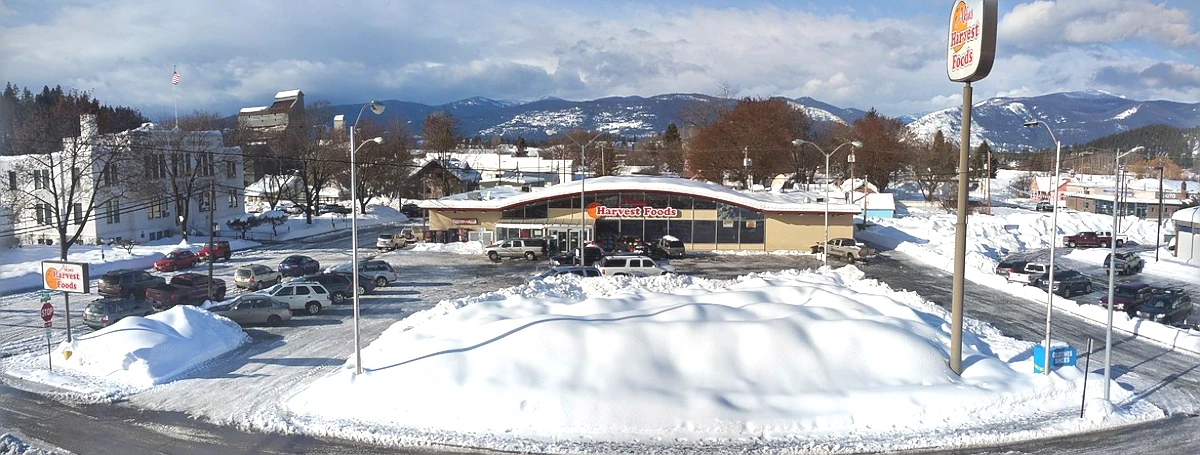 By Mike Weland
By Mike Weland
Boundary County Commission Chair Tim Bertling confirmed that the county closed last week on the sale of the old grocery building downtown that’s been sitting empty since 2017, with plans to move the county courtrooms and other of the busier county offices into. Commissioners have a good idea of what they’d like to see in the 15,000 square foot building and they’re shopping for an architectural firm to work out the details and put the plans to paper.
“We’ve got a long way to go before we can really get started,” Bertling said. “We have to meet with judges and court administrators to find out what they expect for growth and what they want to the courtrooms to look like. One of the first things we need to do is seal the roof.”
The building served as the Bonners Ferry Safeway until 2010, when the new Safeway was built at 6519 Main Street. Later that year, Akins Harvest Foods acquired the lease, operating until 2017.
While the roof needs sealed, the structure, built across Kootenai Street from the courthouse in 1962 at 7168 First Street, is remarkably sound, unlike the courthouse itself, built in 1941 as a Works Progress Administration project for $100,000, which is showing its years.
In addition, acquisition of the building solves a long-standing handicap access conundrum; the courthouse building in compliance with the Americans With Disabilities Act, and because the building is on the National Register of Historic Places, options for providing ADA access to any but the ground floor is technically difficult and prohibitively expensive.
Another benefit of the conversion is that it can be designed to bring courtroom security to a higher standard, getting court security specialists involved early so as to incorporate separate entrances for the courts and other offices, to improve transport and holding of prisoners to and from court, the emplacement of permanent magnetometers and other measures to improve safety of both public and staff.
The work to convert the grocery into government offices and courtrooms will be extensive, and Bertling said all work possible will go to local contractors and subcontractors.
The old Safeway wasn’t the only county acquisition last week; commissioners also closed on the purchase of five acres in the area of the parks and ball fields off District 2 Road, which will be added to the county parks and rec inventory.
“It’s land that fits in perfectly and needed to be part of our parks system,” Bertling said. “It didn’t need to be houses or development.
Both acquisitions were made using American Rescue Plan Act (ARPA) funds, and the purchases very nearly deplete the county’s ARPA account.
“There is a little bit left, but this pretty much wraps up ARPA in Boundary County,” Bertling said. “As a board, each commissioner agreed that these expenditures would give the citizens of Boundary County the greatest benefit, both for the short term and years down the road.”
In other county news, a county-employed planner returns to manage planning and zoning on Friday. Ben Jones, Mead, Washington, has outstanding qualifications and has worked with a variety of entities, including the Lummi Tribe on the Washington Coast. After the retirement of Zoning Administrator John Moss, county commissioners opted to contract planning services with the engineering firm Ruen & Yeager, Sandpoint due to a lack of qualified applicants, but a number of county residents raised concerns that it was difficult to contact P&Z and get accurate and timely assistance with permits. In addition, several expressed concern that there was no enforcement of county land use laws. County commissioners and Jones will work with Ruen & Yeager, Bertling said, to restore P&Z to an in-house function.
At the landfill, the county and the Kootenai Tribe are working together with Green Mountain Composting to establish a food waste composting system under a major grant awarded the tribe and landfill superintendent Richard Jenkins is working toward obtaining permits need to install an air curtain incinerator system to reduce tonnage going into the landfill.
And it seems that a number of people living in around Moyie Springs are just now noticing a gravel pit that’s been operating for years. What they’re actually not seeing is the wall of trees that not long ago blocked the view.
“Because of a sharp increase in vandalism, including significant damage to tools and equipment, we realized a sight barrier of trees was no longer enough to protect the property,” Bertling said, “so the trees have to come out to make way for a fence.”
The proceeds from the sale of the trees, he said, will fund the cost of the fence.
